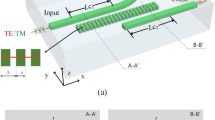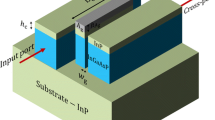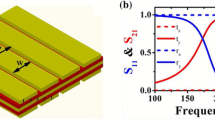Abstract
We propose an ultracompact polarization beam splitter based on an asymmetric directional coupler, which comprises of a horizontally slotted waveguide and a hybrid plasmonic waveguide. The splitter is designed such that there is a large difference between the effective indices of the TE-polarized modes for the two waveguides, while the effective index difference between the TM-polarized modes are quite small in a wide wavelength range. Numerical results demonstrate that the proposed splitter with a short device length of 5 μm shows extinction ratios as low as −20 dB with bandwidths as great as 100 nm.
Similar content being viewed by others
Avoid common mistakes on your manuscript.
1 Introduction
Compact optical device has been explored widespread in recent years. Although it is also possible to use a high-contrast periodic structure, such as a photonic crystal [1, 2], to construct compact optical device by applying the photonic bandgap effect, one can also use total internal reflection, as in conventional waveguides, creating so-called photonic wires. In recent years, silicon-on-insulator (SOI) technology has attracted lots of interests as a platform for the purpose of photonic integrated circuits. These nanophotonic waveguides have small sizes and can be fabricated accurately. In particular, light is guided by the total internal reflection theory like conventional waveguides. However, the high-index contrast between silicon and air/silica makes SOI waveguide highly polarization dependent. To overcome this drawback, a polarization diversity system consisting of on-chip polarization splitters or rotators can be implemented. In general, there have been various design principles of integrated optic polarization splitters in the literature, most of which are based on multimode interference [3–6], directional couplers [7–14], Mach–Zehnder interferometers [15–17], and so on. Among them, directional coupler (DC) may be the most commonly used platform due to its simplicity and easy design. In principle, two approaches have been taken to achieve polarization beam splitting for DC-type waveguides. One design of DC-based polarization splitter is to introduce moderate modal birefringence inherent in optical waveguides, and the polarization-dependent coupling leads to different coupling lengths for the two orthogonal polarizations [8, 9]. Another design is to enhance modal index difference between the two polarizations, such as by using metal overlays on top of the waveguides [18], reduced waveguide dimensions [7], two-mode interference in zero-gap DC [5], or slotted waveguides [10, 13]. As a result, one polarization is entrapped in the incident waveguide, while the other polarization can be freely coupled between the two waveguides. More importantly, it has been possible to realize polarization splitter with ultra-short size. For example, Yue et al. [10] have proposed a polarization splitter with a 46.7 μm length and a 22 dB extinction ratio around 1,550 nm. And Tu et al. [9] experimentally realized a polarization splitter through a 25-μm-long coupler. Recently, a splitter device with a coupling length of only 13.6 μm has been fabricated [13].
Recently, Alam et al. [19, 20] have recently presented a SOI-compatible TM-pass polarizer using the hybrid plasmonic guiding scheme. By changing the dimensions and material properties of the layers, it can force the TE-polarized mode into cutoff, while the TM-polarized mode is well guided. It should be noted that TE- and TM-polarized modes are guided in two different layers in the structure, so their mode indices and properties can be effectively controlled [21–24]. Owing to the high birefringence, such polarizer can be applied to realize novel polarization splitters. For example, Lou et al. [25] proposed a 2 × 5.1 μm2 polarization beam splitter with extinction ratios over 15 dB and insertion losses below 1.5 dB in the full C-band. And very recently, Chee et al. [26] demonstrated an ultrashort integrated polarization splitter with bandwidth larger than 70 nm and extinction ratio lower than 15 dB.
In this article, an on-chip polarization beam splitter (PBS) based on directional coupling between a horizontally slotted waveguide and a hybrid plasmonic waveguide has been necessarily proposed and investigated. The device is designed such that only one polarization state is index matched for the two waveguides, whereas the index difference is very high for the other polarization, which prevents the effective coupling between the two modes of the polarization.
2 Numerical simulation
Figure 1 shows the three-dimensional view for the proposed PBS, the cross section of which is shown in the inset. It can be seen that the left waveguide comprises a low-index nanoscale slot sandwiched between two materials with much higher refractive indices. The substrate is assumed to be silica with the permittivity set to be 2.08, and the cover cladding is defined as air and the refractive index of which is 1. The refractive index of silicon (\(n_{\text{silicon}}\)) is 3.4764. The right waveguide is a hybrid plasmonic waveguide. Both of the widths of the slot waveguide and the plasmonic waveguide are set as 340 nm. The low-index region in the hybrid plasmonic waveguide is silica. The spacer thickness is defined as \(h_{{{\text{SiO}}_{ 2} }}\). The thickness of the slot is \(h_{\text{s}}\) and the refractive index of which can be ranged from 1.47–2.3 [27]. The silicon and metal thicknesses are set as \(t_{\text{m}}\) and \(t_{\text{s}}\), respectively. The gap distance between the two waveguides is defined as d. In the numerical calculation, the permittivity of the silver is simulated using the Drude-Lorentz model with five Lorentz oscillators, where the parameter values of \(\varepsilon_{1}\), \(\omega_{\text{p}}\), \(\omega_{\text{m}}\), \(f_{\text{m}}\), \(\gamma_{\text{m}}\), and damping rate \(\gamma_{\text{p}}\) are presented in Ref. [28]. The default operating wavelength is set as 1,550 nm.
We solve the modes of the individual waveguide in the proposed directional coupler by the finite-element method. Figure 2a shows the effective refractive indices of TE- and TM-polarized modes as a function of the thickness of slot for the plasmonic waveguide. The insets in Fig. 2a show the electric field intensity profiles for TE- and TM-polarized modes with \(h_{{{\text{SiO}}_{ 2} }}\) = 50 nm, respectively. The reduction in silica thickness results in the increase in the effective index for the TM-polarized mode and the decrease in the effective index for the TE-polarized mode. The birefringence is very high at small spacer thickness (e.g., \(h_{{{\text{SiO}}_{ 2} }}\) = 50 nm). This is due to the fact that the TE- and TM-polarized modes are guided in two different layers. The TM-polarized mode supported by the hybrid plasmonic guide is a supermode resulting from the coupling between the SP mode guided by the metal–silica interface and the dielectric waveguide mode guided by the silicon layer. The TE-polarized mode is very similar to conventional dielectric waveguide mode and is concentrated in the high-index region. Consequently, the effective index of TM-polarized mode depends on \(h_{{{\text{SiO}}_{ 2} }}\). Figure 2b shows the effective indices of the TE- and TM-polarized modes in the slotted waveguide. We can see from Fig. 2b that the effective indices of TE- and TM-polarized modes decrease with the increased slot thickness, and the effective index of TE-polarized mode is larger than that of TM-polarized mode when the refractive index of slot (\(n_{\text{S}}\)) is reduced.
Effective indices for the slotted and plasmonic waveguides with w = 340 nm, \(t_{\text{m}}\) = \(t_{\text{s}}\) = 200 nm, T = 2 μm. The operating wavelength is 1,550 nm. a Effective indices of TE- and TM-polarized modes as functions of \(h_{{{\text{SiO}}_{ 2} }}\). The inset shows mode profiles of the TE- and TM-polarized modes of the slot waveguide. b Effective indices of the TE- and TM-polarized modes for slot waveguide as a function of \(h_{\text{s}}\)
Based on the above analysis, we set the structural parameters to be \(t_{\text{m}}\) = \(t_{\text{s}}\) = 200 nm, \(h_{\text{s}}\) = \(h_{{{\text{SiO}}_{ 2} }}\) = 50 nm, and T = 2 μm. We plot in Fig. 3 the effective index curves of the fundamental modes in two waveguides. We can see from the figure that the index difference between the TM-polarized states of the two waveguides is very small and the index difference between the TE-polarized states of the two waveguides is very large in the wavelength range. As a result, the TM-polarized states of the slot and plasmonic waveguide are index matched in a wide wavelength range. On the other hand, the large index difference between the TE-polarized states indicates that there is a serious phase mismatching, and consequently, the evanescent coupling can be suppressed very significantly for the TE-polarized light.
To achieve short device size, we assumed gap distance d as 150 nm. Alternatively, the operational principle of this PBS can also be explained in terms of the supermodes of the two-core directional coupler. If the individual cores of the coupler are single mode guided, the coupler structure supports two modes, one odd mode and one even mode. At the resonant wavelength, the power transfer efficiency from one outside waveguide to the other can be maximized and the coupling length L can be calculated using the following equation:
where \({{\upbeta}}_{\text{e}}^{\sigma }\)and \({{\upbeta}}_{\text{o}}^{\sigma }\)are the propagation constants of even and odd supermodes, respectively, and \(\sigma\) is a polarization-state index. The magnetic field distributions of the TE- and TM- polarized supermodes at 1,550 nm are shown in Fig. 4. Owing to the index-matched coupling, the two supermodes of the TM-polarized state are hybrid modes, the fields are located in the two waveguides. On the other hand, almost all of the power of the TE-polarized state remain in the individual waveguide, and this can be concluded by Fig. 4c, d. When light is launched from the left waveguide, the TM-polarized light will be coupled to the plasmonic waveguide completely at a length \({\text{L}}_{\text{c}}^{TM}\), where \({\text{L}}_{\text{c}}^{TM}\) is the coupling length of the TM-polarized mode. Fig. 5 shows the normalized optical intensities from the two outputs versus coupler length at λ = 1,550 nm. We can see if the waveguide length is chosen to be L = \({\text{L}}_{\text{c}}^{TM}\), which is 5 μm in this situation, then the two polarizations can be separated. We can also see the introduction of the plasmonic waveguide will lead to the reduction in the output power of the two polarizations, especially for the TM-polarized state. Owing to the small coupling length, the introduced losses are very small. The corresponding losses for the TE- and TM-polarized states induced by the plasmonic waveguide are 0.08 and 0.17 dB, respectively.
Figure 6 shows the spectra of normalized output power at the left waveguide and the right waveguide, for TE- and TM-polarized input excitations at the left waveguide with a waveguide length of L = 5 μm. The extinction ratios, defined as the power ratio between the undesired and the desired polarized states in each output waveguide, are ERTE = −27 dB for the left waveguide and ERTM = −56 dB for the right waveguide at λ = 1,550 nm, respectively. In addition, the wavelength ranges where the extinction ratios below −20 dB are from 1,500 to 1,600 nm for TM-polarized state. Therefore, the extinction ratios remain below −20 dB over a 100 nm wavelength range for both of polarizations.
3 Conclusion
In conclusion, an ultracompact PBS based on an asymmetrical DC with a horizontally slotted waveguide and a hybrid plasmonic waveguide has been proposed. The introduction of the metal clad waveguide resulted in a large effective index difference between TE-polarized modes, which contributes to the realization of the ultrasmall PBS.
References
X. Ao, L. Liu, L. Wosinski, S. He, Polarization beam splitter based on a two-dimensional photonic crystal of pillar type. Appl. Phys. Lett. 89, 171115 (2006)
J. Feng, Z. Zhou, Polarization beam splitter using a binary blazed grating coupler. Opt. Lett. 32, 1662–1664 (2007)
J.M. Hong, H.H. Ryu, S.R. Park, J.W. Jeong, S.G. Lee, E.H. Lee, S.G. Park, D. Woo, S. Kim, O. Beom-Hoan, Design and fabrication of a significantly shortened multimode interference coupler for polarization splitter application. Photon. Technol. Lett. IEEE. 15, 72–74 (2003)
Y. Jiao, D. Dai, Y. Shi, S. He, Shortened polarization beam splitters with two cascaded multimode interference sections. Photon. Technol. Lett. IEEE. 21, 1538–1540 (2009)
B.K. Yang, S.Y. Shin, D. Zhang, Ultrashort polarization splitter using two-mode interference in silicon photonic wires. Photon. Technol. Lett. IEEE. 21, 432–434 (2009)
A. Hosseini, S. Rahimi, X. Xu, D. Kwong, J. Covey, R.T. Chen, Ultracompact and fabrication-tolerant integrated polarization splitter. Opt. Lett. 36, 4047–4049 (2011)
I. Kiyat, A. Aydinli, N. Dagli, A compact silicon-on-insulator polarization splitter. Photon. Technol. Lett. IEEE. 17, 100–102 (2005)
T. Yamazaki, H. Aono, J. Yamauchi, H. Nakano, Coupled waveguide polarization splitter with slightly different core widths. J. Lightwave Technol. 26, 3528–3533 (2008)
X. Tu, S.S.N. Ang, A.B. Chew, J. Teng, T. Mei, An ultracompact directional coupler based on GaAs cross-slot waveguide. Photon. Technol. Lett. IEEE. 22, 1324–1326 (2010)
Y. Yue, L. Zhang, J.Y. Yang, R.G. Beausoleil, A.E. Willner, Silicon-on-insulator polarization splitter using two horizontally slotted waveguides. Opt. Lett. 35, 1364–1366 (2010)
K. Saitoh, M. Koshiba, Design of miniaturized silicon wire and slot waveguide polarization splitter based on a resonant tunneling. Opt. Express 17, 19225–19233 (2009)
D. Dai, Z. Wang, J.E. Bowers, Ultrashort broadband polarization beam splitter based on an asymmetrical directional coupler. Opt. Lett. 36, 2590–2592 (2011)
S. Lin, J. Hu, K.B. Crozier, Ultracompact, broadband slot waveguide polarization splitter. Appl. Phys. Lett. 98, 151101 (2011)
L. Liu, Y. Ding, K. Yvind, J.M. Hvam, Silicon-on-insulator polarization splitting and rotating device for polarization diversity circuits. Opt. Express 19, 12646–12651 (2011)
T. Liang, H. Tsang, Integrated polarization beam splitter in high index contrast silicon-on-insulator waveguides. Photon. Technol. Lett. IEEE. 17, 393–395 (2005)
L. Augustin, R. Hanfoug, J. van der Tol, W. de Laat, M. Smit, A compact integrated polarization splitter/converter in InGaAsP–InP. Photon. Technol. Lett. IEEE. 19, 1286–1288 (2007)
D. Dai, Z. Wang, J. Peters, J. Bowers, Compact polarization beam splitter using an asymmetrical Mach-Zehnder Interferometer based on silicon-on-insulator waveguides. Photon. Technol. Lett. IEEE. 24, 673–675 (2011)
K. Thyagarajan, S. Diggavi, A.K. Ghatak, Integrated-optic polarization-splitting directional coupler. Opt. Lett. 14, 1333–1335 (1989)
M. Alam, J.S. Aitchsion, M. Mojahedi, Compact hybrid TM-pass polarizer for silicon-on-insulator platform. Appl. Opt. 50, 2294–2298 (2011)
M. Alam, J.S. Aitchison, M. Mojahedi, Compact and silicon-on-insulator-compatible hybrid plasmonic TE-pass polarizer. Opt. Lett. 37, 55–57 (2012)
R.F. Oulton, V.J. Sorger, D. Genov, D. Pile, X. Zhang, A hybrid plasmonic waveguide for subwavelength confinement and long-range propagation. Nat. Photonics 2, 496–500 (2008)
D. Dai, S. He, A silicon-based hybrid plasmonic waveguide with a metal cap for a nano-scale light confinement. Opt. Express 17, 16646–16653 (2009)
M. Fujii, J. Leuthold, W. Freude, Dispersion relation and loss of subwavelength confined mode of metal-dielectric-gap optical waveguides. Photon. Technol. Lett. IEEE. 21, 362–364 (2009)
M. Wu, Z. Han, V. Van, Conductor-gap-silicon plasmonic waveguides and passive components at subwavelength scale. Opt. Express 18, 11728–11736 (2010)
F. Lou, D. Dai, L. Wosinski, Ultrashort broadband polarization beam splitter based on an asymmetrical directional coupler. Opt. Lett. 37, 3372–3374 (2012)
J. Chee, S. Zhu, G.Q. Lo, CMOS compatible polarization splitter using hybrid plasmonic waveguide. Opt. Express 20, 25345–25355 (2012)
R. Machorro, E. Samano, G. Soto, F. Villa, L. Cota-Araiza, Modification of refractive index in silicon oxynitride films during deposition. Mater. Lett. 45, 47–50 (2000)
W. Chen, M.D. Thoreson, S. Ishii, A.V. Kildishev, V.M. Shalaev, Ultra-thin ultra-smooth and low-loss silver films on a germanium wetting layer. Opt. Express 18, 5124–5134 (2010)
Acknowledgments
This work is supported by the National Natural Science Foundation of China (NNSFC) (Grant No. 61275153), the Qing Lan Project of Jiangsu Province, and the Innovation Program of Graduated Student of Jiangsu Province (Grant No. CXZZ11_0547).
Author information
Authors and Affiliations
Corresponding author
Rights and permissions
About this article
Cite this article
Sun, B., Chen, MY., Zhang, YK. et al. An ultracompact hybrid plasmonic waveguide polarization beam splitter. Appl. Phys. B 113, 179–183 (2013). https://doi.org/10.1007/s00340-013-5453-y
Received:
Accepted:
Published:
Issue Date:
DOI: https://doi.org/10.1007/s00340-013-5453-y










